FIRST MAJOR MESS UP ON THIS PROJECT - 5TH STRING PEGI decided to drill the hole for the geared 5th peg and hand taper
afterwards and have done a bunch of them over the years and most were just done by "eye" so
to speak without a dedicated fixture and never had a problem. I gave away my custom modified hand
reamer thinking I didn't have a need for it and ordered another one from one
of the musical instrument suppliers and did notice their reamer was a lot
longer than my custom one although they had modified the reamer length and had a much smaller beginning taper no doubt
for some of the smaller plain traditional 5th pegs. A few pixs below:
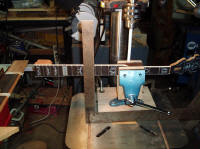
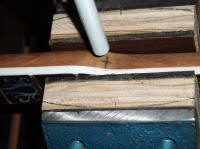
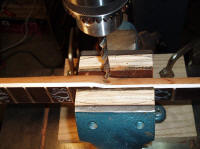
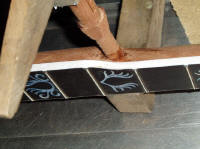
Prior to the above set-up, I drilled test holes in a scrap piece of
walnut wood and checked the hand tapered reamer and noticed it was too small
at the start of the tapered end and would require shortening to work with
this 5th string geared peg and didn't see a problem with that. After
squaring up the neck in the vise and using an alignment tool in the drill
press, I drilled the hole for the geared 5th peg in small increments
until I got to a little over 5/16 inch and drilled to the depth of the truss
rod and all was well. In order to cut the reamer to the length needed,
I had to use a angle head grinder and after squaring off the bottom of the
tapered reamer, I failed to take the time to do a test run on scrap material
and did not check the diameter with my micrometer so now I had two
human errors compounded and ready for a disaster to happen
and it certainly did! I rotated the tapered reamer in the hole drilled
and the 5th string geared peg would literally drop into the hole. In
order to salvage this neck, I drilled the tapered hole to have straight
walls and made a mahogany peg to fit the hole tightly, hand cut a few
"splines" in it for air to escape from the hole and glued it in place and
hopefully will not be too noticeable since I plan to move the original hole
up a little over 1/16 of an inch to where the "splined" shaft will be barely
touching the fingerboard binding or very close to it anyway. I will
round up another tapered reamer and I know one fine craftsman that uses a
modified large file tang cut to the proper length for reaming the 5th string
peg hole. There is nothing high tech or complicated about installing a
geared 5th peg but what can I say....I messed up! Brain Dead!
I used regular metal drill bits manufactured by Greenlee of which that
set is many decades old and back then were excellent quality although not
the best and have added replacements to it over the years sharpening them
many times; however all drill bits are not the same. For drill
bits, you certainly do get what you pay for. A much better drill bit
type would be the brad point and not a cheap complete set from 1/8
inch to 1/2 inch in 64ths of an inch increments that cost around 30 to 50
dollars.....they are not worth chucking in your drill press; most are not
true and the diameters are not precision either. Figure on the average
of paying about 10 dollars per drill bit and that will give you an idea of
something of quality. A regular metal drill bit without a good solid
fixture and a good tapered pilot hole, the drill bit will wander on you if
you are not careful. While talking about drill bits, a quality brad
point point is for the serious wood worker and the Forstner type is for the
amateurs and I have certainly used my share of the Forstner drill bits
because they are cheaper but again, most of the time, "You
get what you pay for". As for drilling the 5th string peg hole,
you are somewhat handicapped by the brad point since you don't have a lot of
extra depth to deal with but there is just enough room if your brad point
drill bit doesn't have a long brad point which normally is no longer than
the front taper of a regular metal drill bit. I have ordered custom brad point drill bits with a
special shortened brad point for my turkey box call lids and they can get a
little pricy when the diameter is over 1/2 inch but well worth the price.
I highly recommend W.L. Fuller bits and countersinks.
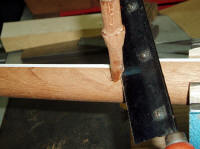
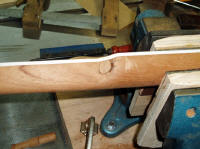
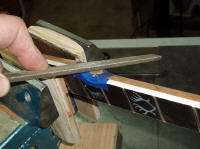

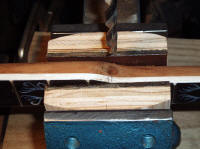
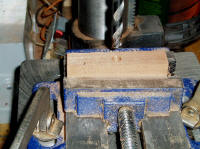
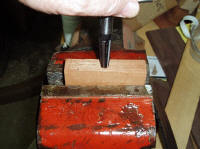
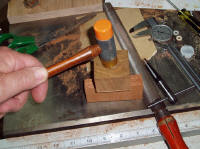
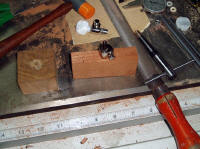
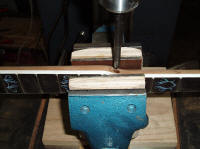
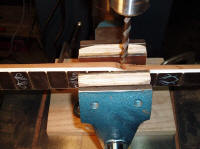
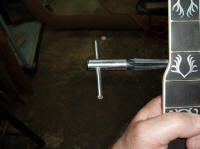
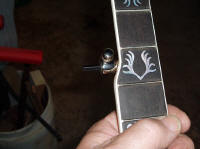
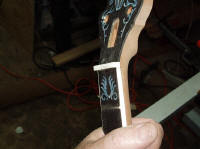
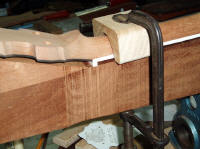
After the glue dried overnight, I cut the mahogany peg fairly close to
the neck with a small fret back saw and taped around the peg insert with
masking tape and filed it to the radius to match the neck curvature. I
again went through the process of leveling the neck blank up and marked off
the position to drill the first pilot hole for the geared 5th string peg and
drilled in 1/16 inch or less increments until I had the hole at 5/16 inch in
diameter. Since I destroyed my hand tapering tool by grinding the
length too short which in essence made the outside diameter oversize for the
geared 5th string peg to have a "press fit", I will have to
purchase another one or improvise by grinding down an ole flathead screw
driver or cut the tang off an ole file which is about the right taper or
very close to it. In all probability, I will order one although the
shipping charges will be as much as the tool cost itself. In the
meantime, I will get some sanding time in on the banjo neck which is a
momentous but very important task for a proper finish.
I got another reamer in and did another test run on a scrap piece of
Honduras Mahogany and my final drill hole was 21/64 inches in diameter which
matched the the small end of the reamer. I removed the button from the
5th peg shaft and drilled a 3/16 inch diameter hole in a wood block and
gently tapped the 5th string peg seating it and all was well.
My neck had a 5/16 inch diameter hole predrilled in the plug that I had
to install and again went through the process of squaring aka leveling the
neck up in the vise and centered the hole with the drill press chuck by
using a 5/16 inch diameter center punch and clamped the vise down. I
drilled a 21/64 inch hole to the depth of the truss rod and hand reamed the
hole out a little at a time to be certain I did not ream the hole oversize
as I did before. The 5th string peg fit very well and will drive it to
the proper depth after the neck is finished.
The last two pixs on the far right above where I fitted and glued the
bone nut blank in place. I probably should have done more pre-shaping
to the actual finish size as far as the height and taper toward the peghead
but will do that after finishing and assembly.
DRILLING PEGHEAD TUNER HOLES
I believe most small shops and individuals making only a neck once in a
while will drill the holes for the tuners without the aid of special made
fixtures using hardened drill bushings but jigs and fixtures do tend to make
it more "fail safe" and accurate. I am not going to "reinvent" the
wheel for this operation and the drilling will be totally freehand. After laying
out and marking the drill bit location with a hand center punch, I used a
25/64 inch drill bit since I plan to install a set of the Schaller D tuners
and a little extra play on the 1st and 4th tuner hole want make that much
difference....a little less lacquer to remove from the holes...grin if you
must.

A much safer and accurate method would be to locate the center punch mark
and bring the drill press brad point bit in contact with the center punch
mark verifying the center and clamp the peghead to the drill press table.
The brad point bit makes a very clean hole and I would recommend a drill
press speed of around 800 to 1000 rpm to prevent heating the drill bit.
The above bit was made by W.L. Fuller Company and a good quality drill bit
as are all of the items they manufacture here in the USA. The
sacrifice backer board underneath the back of the peghead is necessary to
prevent the exit hole from splintering/chipping. Drilling the holes
for the 1st and 4th tuners require repositioning the drill press table since
the start of the hand volute taper is near those holes.
DRILLING FINGERBOARD SIDE DOT POSITION MARKERS
For the side dot material I planned to use a 3/32 inch diameter plastic
black rod marketed for this purpose, however after looking at the size, I
immedialy didn't like the diameter and decided to go back to old school
stuff drilling a hole and filling it with a black epoxy mix, although I have
seen many of THE GREAT DEPRESSION ERA Mastertones with that
size side dots in them. I
penciled the position of each position marker and marked two places at the
12th fret and all other position markers 1, 3, 5, 7, 10, 15, 17, 19 and 22nd
has only one position dot. I then hand drilled the holes using a
tapered drill bit not much over 1/16 inch in diameter and drilled them by
hand without a hand drill. I used Stew Mac's 20-B black super glue and
filled each drilled hole and will alloy to dry overnight. I used a
small scribe to help the super glue get down into the drilled hole.
When dry, I will
sand flush with the fingerboard binding and hope it works as well as it use
to.










I didn't like the looks of the side position dots using the black super
glue and ordered a couple pieces of black plastic side dot material and will
redo the above. The black super glue didn't settle into the hole
drilled and after applying another small drop, it still settled below the
level of the binding. Oh well, the old blackened Epoxy 330 worked
great in the 1970s...grin if you must.
DRILLING NECK HANGER BOLTS AKA LAG SCREWS












In order to use my neck shaping jig with the nut installed, I had to cut an opening in the jig
to allow for the installed nut to properly clamp the neck down for the neck
hanger bolts. Prior to the actual drilling, I placed the neck heel
against the pot assembly and using a 3/16 inch diameter transfer center punch
referencing off the neck lag bolt holes drilled into the wood rim and tapped the
transfer center punch lightly with a small fret hammer to make a witness mark on the end of
the heel for the location of each hanger bolt. I checked the diameter of
the hanger bolts and they were .150 to .155 inches in diameter at the base
portion of the screw threads and did a test drill on a piece of scrap end
grain Honduras Mahogany and the 1/8 inch diameter pilot hole drilled was a
little to tight for comfort. I will do another test drilling using a
9/64 inch diameter bit which is around .140 inches which should be about
right for the Mahogany. It is important to keep the drill bit in the
same plane as the neck heel which in this case it will be 90 degrees in
reference to the portion of the neck heel that makes contact with the wood
rim although the neck has a 3 degree angle. The 10-32 hanger bolts are
fairly malleable and will self-align once tension is applied from the
coordinator rods but you want them as square and plumb as possible. A
good coat of Johnson's paste wax to the threads of the hanger bolts per
Frank Neat does
help when installing them and aids in removing them if necessary as well.
Many of THE GREAT DEPRESSION ERA Mastertones shows evidence
where the factory assemblers elongated the two hanger bolt holes (North to
South Direction) in the wood rim to get the banjo neck to fit the wood rim
properly and a sign of a high production environment and not just on a
Monday or Friday either. The witness marks on the neck heel from the
transfer center punch was not too far off center from the earlier scribed
center line that I marked on the heel after I sanded the curvature for the
heel. The distance between the two hole centers was about 1.300 inches,
pretty close to specifications.
LEAVING ON A
SPIRITUAL NOTE
If you do not know Jesus Christ as your Lord and Savior, please take this
moment to accept him by Faith into your Life, whereby Salvation will be
attained.
Ephesians 2:8 - 2:9 8 For by grace are ye saved through faith;
and that not of yourselves: [it is] the gift of God: 9 Not of works, lest
any man should boast.
Hebrews 11:1 “Now faith is the substance of things hoped for, the
evidence of things not seen.”
Romans 10:17 “So then faith cometh by hearing, and hearing by the
word of God.”
Open this
link about faith in the King James Bible.
Romans 10:9 “That if thou shalt confess with thy mouth the Lord
Jesus, and shalt believe in thine heart that God hath raised him from the
dead, thou shalt be saved.”
Open this
link of Bible Verses About Salvation, King
James Version Bible (KJV).
Hebrews 4:12 “For the word of God is quick, and powerful, and
sharper than any two edged sword, piercing even to the dividing asunder of
soul and spirit, and of the joints and marrow, and is a discerner of the
thoughts and intents of the heart.”
Romans 6:23 “For the wages of sin is death; but the gift of God is
eternal life through Jesus Christ our Lord.”
Romans 3:23 “For all have sinned, and come short of the glory of
God;”
Micah 6:8 “He hath shewed thee, O man, what is good; and what doth
the LORD require of thee, but to do justly, and to love mercy, and to walk
humbly with thy God?”
Philippians 4:13 "I can do all things through Christ which
strengtheneth me."
PREVIOUS PAGE
NEXT PAGE
BANJO CONSTRUCTION HOME PAGE
